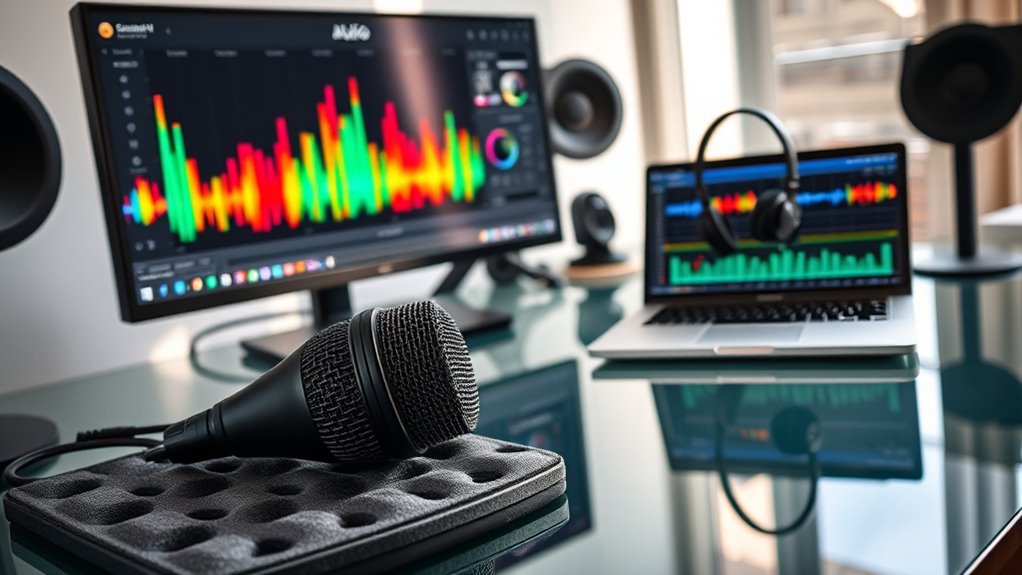In your audio analysis workflow, you start by processing raw sound signals to remove noise, normalize volume, and prepare data for feature extraction. Next, you identify key attributes like spectral properties, pitch, or tempo using techniques like MFCCs or STFT. These features simplify complex audio into patterns, improving accuracy for classification or recognition tasks. If you keep exploring, you’ll uncover how each step fine-tunes the process for better insights.
Key Takeaways
- We begin by capturing raw audio signals and applying noise reduction for clarity.
- Next, we normalize the audio to ensure consistent volume levels across recordings.
- We extract key features such as MFCCs, spectral properties, and pitch to summarize sound characteristics.
- These features are used to train and refine machine learning models for accurate analysis.
- Throughout the process, we iteratively adjust filters and parameters to optimize results and improve reliability.

Understanding the audio analysis workflow is essential for anyone working with sound data, whether you’re developing a music app, conducting research, or enhancing speech recognition. At the core of this process lies signal processing, the method of transforming raw audio signals into meaningful information. When you start analyzing sound, you first capture the audio waveform, which is a complex mixture of frequencies, amplitudes, and timings. Signal processing techniques help you clean, filter, and prepare this data for further analysis. For example, noise reduction filters remove unwanted background sounds, while normalization ensures consistent volume levels across different recordings. These steps are vital because they set the foundation for accurate feature extraction. Additionally, leveraging expert voice actors can help improve the quality of training data in voice-related projects, enhancing overall analysis accuracy.
Once you’ve prepped the audio data, the next step is feature extraction. This process involves identifying and isolating specific attributes of the sound that are relevant to your analysis goals. Think of features as the key characteristics that summarize the audio’s content without needing to process the entire waveform each time. Common features include spectral properties, pitch, tempo, and timbre. You might use techniques like Short-Time Fourier Transform (STFT) or Mel-Frequency Cepstral Coefficients (MFCCs) to convert the raw signal into a more manageable form. These features allow your algorithms to distinguish between different sounds, speakers, or musical genres more effectively. The challenge here is selecting the right features that carry the most meaningful information for your specific application.
As you move through the workflow, feature extraction feeds into modeling and classification stages. Equipped with a set of relevant features, you can train machine learning models, recognize patterns, or perform clustering. This step is where your understanding of the signal processing techniques directly impacts the accuracy of your results. For example, if you’re working on speech recognition, extracting features that highlight phonetic differences is critical. If you’re analyzing music, focusing on spectral features can help identify genres or instruments. The entire process relies on a tight integration between signal processing and feature extraction, guaranteeing that the data fed into your models truly reflects the essential qualities of the audio.
Throughout the workflow, it’s important to iterate and refine each step. Adjusting filters, choosing different features, or experimenting with processing parameters can markedly improve outcomes. Ultimately, mastering the interplay between signal processing and feature extraction forms the backbone of effective audio analysis, enabling you to reveal insights hidden within sound data with precision and confidence.
Frequently Asked Questions
What Are the Common Challenges in Audio Analysis?
You often face challenges like noise reduction, which can distort important audio details, making analysis difficult. Extracting relevant features amid background sounds or overlapping signals also proves tricky, impacting accuracy. Variability in audio quality, such as recording conditions or equipment differences, adds complexity. To overcome these issues, you need effective noise filtering techniques and robust feature extraction methods that adapt to diverse audio environments, ensuring reliable analysis results.
Which Tools Are Best for Real-Time Audio Processing?
You should consider tools like Adobe Audition, Ableton Live, or specialized software like Spear for real-time audio processing. These tools excel at noise reduction and feature extraction, allowing you to clean up audio and identify key elements instantly. They offer real-time capabilities, enabling you to monitor and adjust audio on the fly. This helps improve accuracy and efficiency, especially when handling dynamic or live audio environments.
How Do You Ensure Data Privacy During Analysis?
Did you know that over 70% of users worry about data privacy? To protect your information during analysis, you implement robust privacy safeguards like end-to-end encryption and strict access controls. You also use data anonymization techniques, removing identifying details to prevent misuse. These steps make sure your data stays secure, maintaining your trust and confidentiality throughout the audio analysis process.
Can Audio Analysis Improve With Machine Learning?
Yes, audio analysis can improve considerably with machine learning. By leveraging deep learning, you can automatically learn complex patterns and improve accuracy. Feature extraction plays a vital role, enabling your models to identify key audio characteristics. As you train these models on diverse datasets, they’ll become better at recognizing nuances, ultimately enhancing the quality and reliability of your audio analysis results.
How Long Does a Typical Audio Analysis Project Take?
A typical audio analysis project takes about 4 to 8 weeks, depending on complexity. Interestingly, 60% of the timeframe is spent on ensuring high audio quality and thorough data annotation. Your team must focus on capturing clear sound and accurately labeling data, because these steps directly influence the accuracy of results. Proper planning and quality control can help streamline the process, saving time and improving overall analysis outcomes.
Conclusion
By following this audio analysis workflow, you unlock valuable insights hidden in every sound. Did you know that over 90% of data created today is unstructured, making audio analysis more vital than ever? Embracing this process empowers you to extract meaningful patterns, improve decision-making, and innovate in your field. So, keep refining your approach, and you’ll discover the true potential of every audio file you analyze. The possibilities are endless when you listen carefully.









